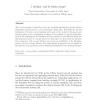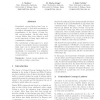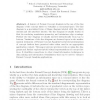102
Voted
ISCI
2010
14 years 11 months ago
2010
The t-concept lattice is introduced as a set of triples associated to graded tabular information interpreted in a non-commutative fuzzy logic. Following the general techniques of ...
118
Voted
CLA
2004
15 years 2 months ago
2004
In Formal Concept Analysis, it is a very important but quite difficult task to draw line diagrams of concept lattices automatically. In particular, we want every planar lattice to ...
131
Voted
NIPS
2008
15 years 2 months ago
2008
We propose a novel application of Formal Concept Analysis (FCA) to neural decoding: instead of just trying to figure out which stimulus was presented, we demonstrate how to explor...
110
Voted
EUSFLAT
2007
15 years 2 months ago
2007
Generalized concept lattices have been recently proposed to deal with uncertainty or incomplete information as a non-symmetric generalization of the theory of fuzzy formal concept...
104
click to vote
DLOG
2008
15 years 3 months ago
2008
Formal Concept Analysis (FCA) is an approach to knowledge engineering, representation, and analysis. A `standard' FCA-workflow starts with some `experimental' data, class...
106
click to vote
STACS
1991
Springer
15 years 4 months ago
1991
Springer
Several relation-algebraic algorithms for computing the cut completion of a partially ordered set are formally developed and afterwards generalized to the case of concept lattices....
110
Voted
ICFCA
2007
Springer
15 years 4 months ago
2007
Springer
Several fuzzifications of formal concept analysis have been proposed to deal with uncertainty or incomplete information. In this paper, we focus on the new paradigm of multi-adjoin...
112
Voted
GD
1994
Springer
15 years 4 months ago
1994
Springer
Abstract. Concept lattices are used in formal concept analysis to represent data conceptually so that the original data are still recognizable. Their line diagrams should re ect th...
108
click to vote
ICFCA
2010
Springer
15 years 5 months ago
2010
Springer
A feature of Formal Concept Analysis is the use of the line diagram of the concept lattice to visualize a conceptual space. The line diagram is a specialized form of Hasse diagram ...
96
Voted
IPPS
2002
IEEE
15 years 5 months ago
2002
IEEE
This paper discusses concept lattices and some of their applications in component library development and compiler optimizations. Ongoing work on concept-based userextensible simp...



